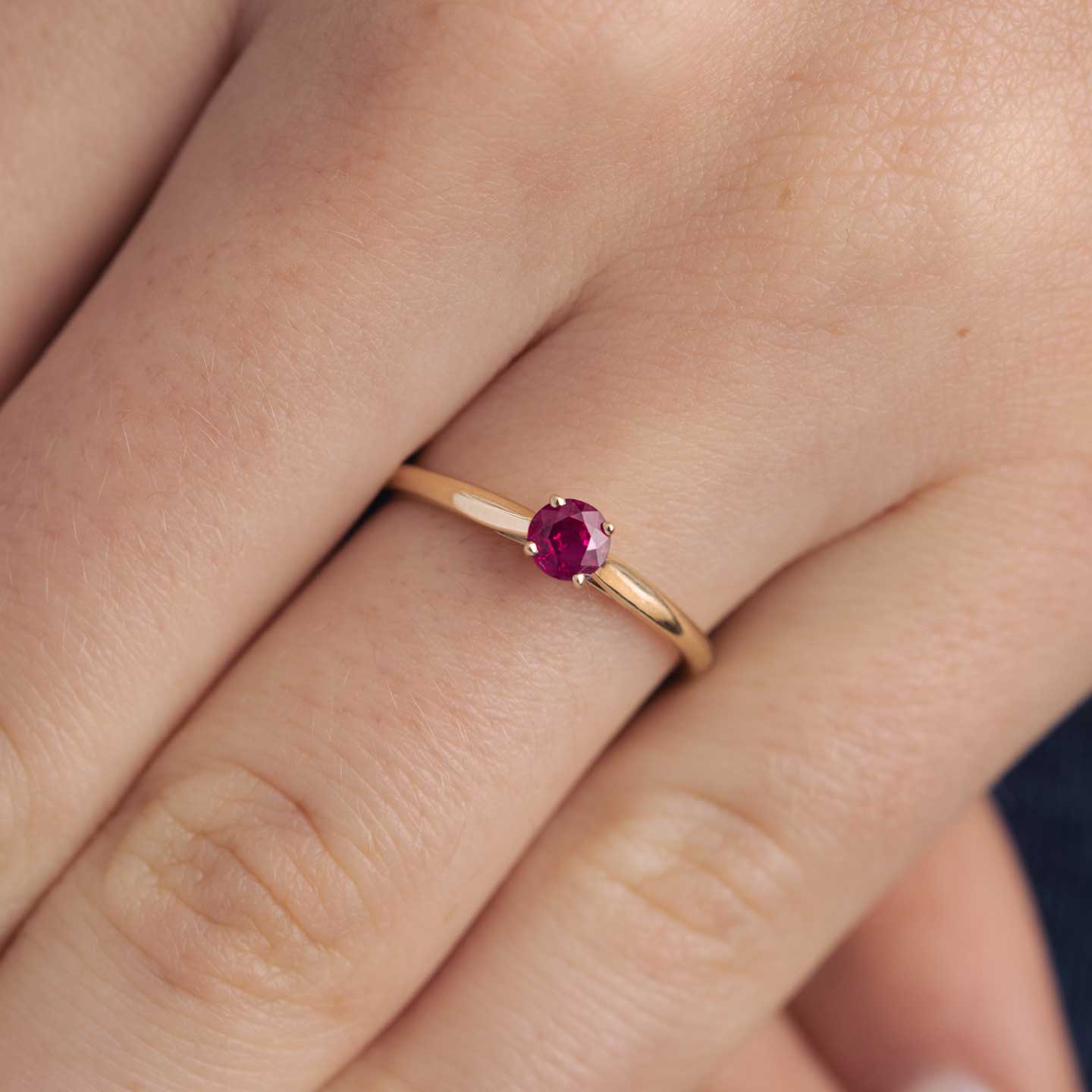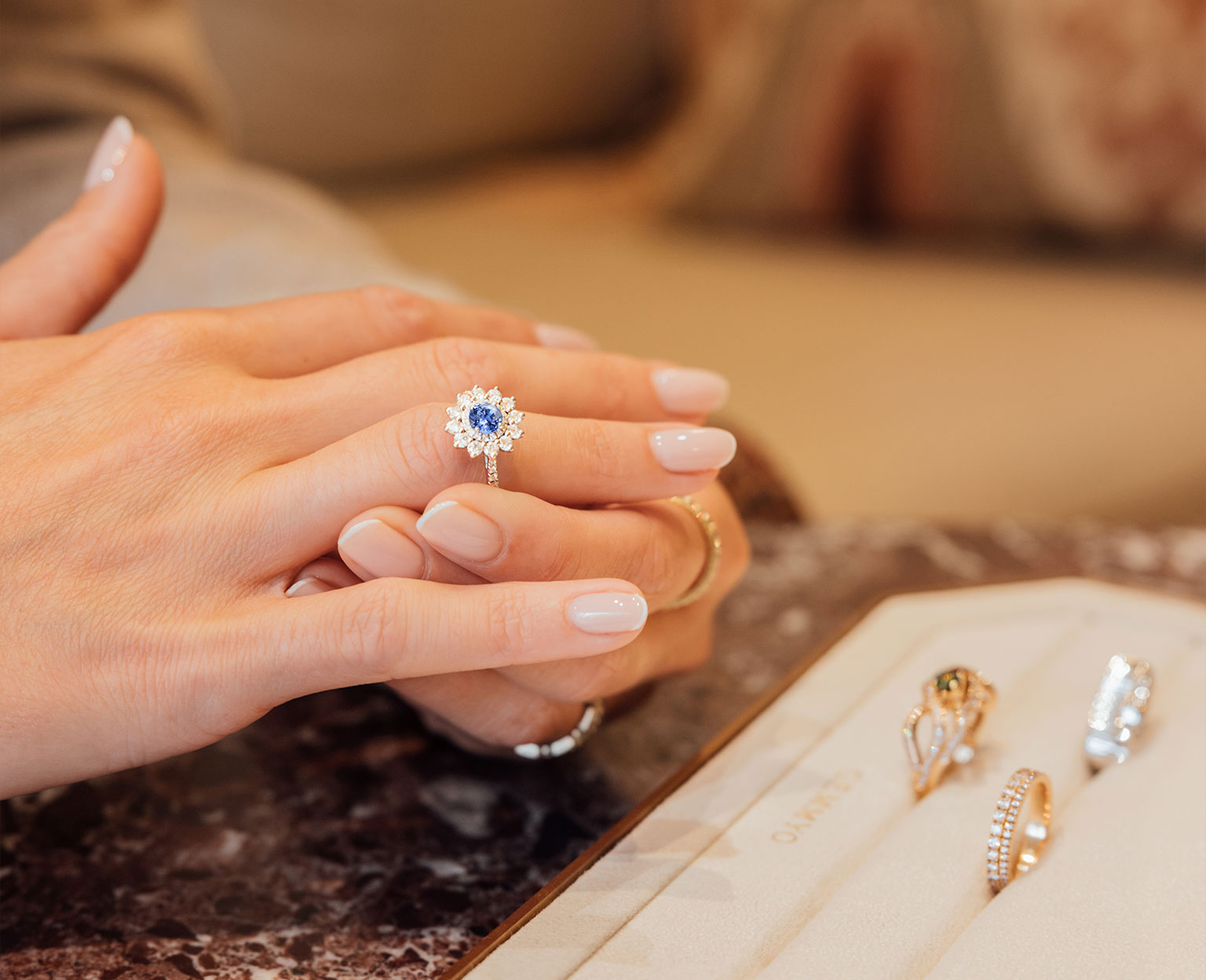For most of us, the ruby is undoubtedly one of the stones that best represents the world of jewelry and the precious. It is one of the four stones commonly referred to as précieuses along with diamonds, sapphires and emeralds.
What are its main characteristics? Are rubies suitable for everyday wear? Is it a stone that can be offered for an engagement ring? What is a “sang de pigeon” (pigeon blood) ruby?
In this guide, we reveal all the secrets of the ruby, a historic gemstone that is particularly appreciated for its exceptional colour!
Before we get to the heart of the matter, let's first take a look at the history of the ruby and its origins.
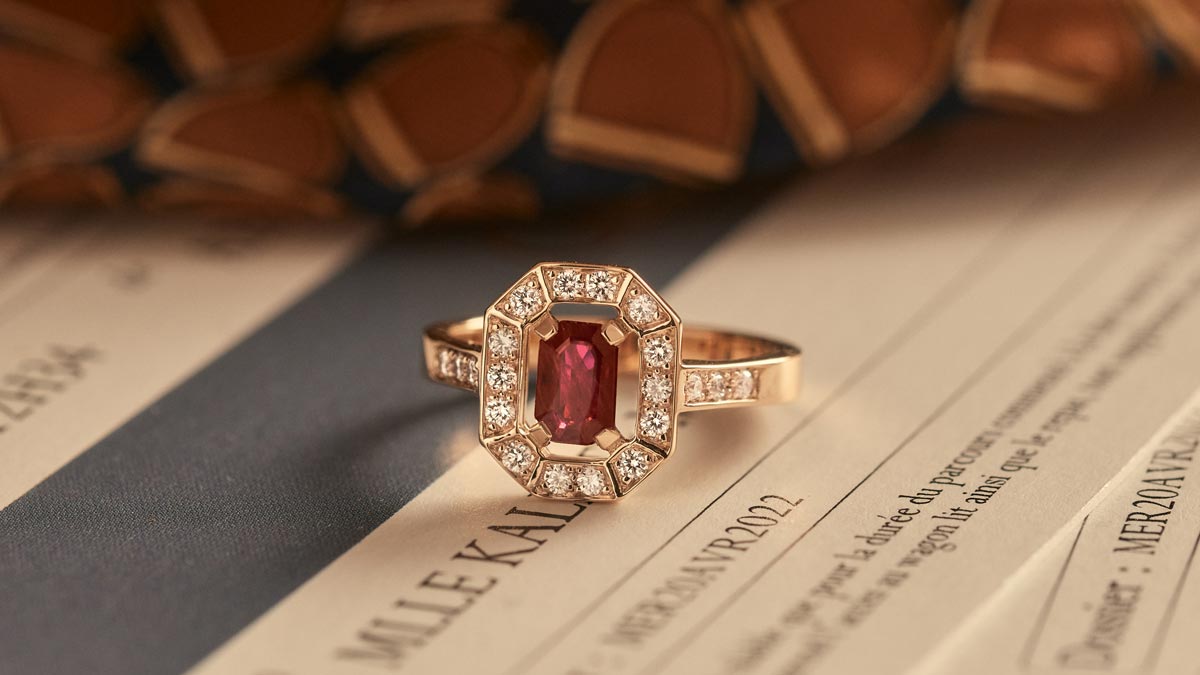
The history of ruby
The first extractions of rubies took place in the 8th century BC in Sri Lanka.As with most precious stones, it was very early on attributed with spiritual and medical virtues.
In ancient times, rubies were said to have the power to resist poison and to make sadness disappear. In the Middle Ages, Christian kings wore it on their crowns as a symbol of the blood of Christ.
Since the dawn of time, the ruby has been the stone symbol of desire, passion and also power. For a long time it was even considered the most precious of stones. Its first name was Ratnaraj, which means - queen of precious stones - in Sanskrit.
The name ruby as we use it today comes from Rubens which means red in Latin.
For centuries, ruby was often confused with garnet or red spinel because of their similarity! Rightly so, they are sometimes found in the same geological formations.
Did you know that?
A stone called the Black Prince's Ruby can be seen on the English crown. This stone, which weighs about 170 carats, is actually a spinel and not a ruby as was believed for centuries!
The origins of ruby
Today, the main producers of rubies are Mozambique, Sri Lanka, Thailand and Burma.Historically, Burma was the leader in world production. However, Burmese mines have been so heavily mined for centuries that it is now much more difficult to find new deposits. As a result, the majority of Burmese rubies have already been in circulation for decades and new world production is more likely to come from Mozambique, Thailand or Sri Lanka.
The ruby valley
It is in the heart of the Burmese jungle, in the famous Mogok Valley, that three quarters of the world's rubies are found, including the famous rubies known as pigeon's blood.
This name describes rubies of a very precise tone: a clear, intense red, often with a slight hint of blue. These rubies are extremely rare - much rarer than coloured diamonds!
In fact, the most expensive ruby in history is a 25.59-carat pigeon's blood Burmese ruby that was auctioned off in 2015 for $30 million.
The main characteristics of ruby
The ruby - like the sapphire - is a member of the corundum family. Simply put, a ruby is such arare and prized variety of red sapphire that it has been given the name ruby.
The ruby is a gem with three main characteristics:
—— 1. Extreme hardness
With 9/10 on the Mohs scale, ruby is one of the top three hardest minerals on the planet. Only a diamond or moissanite can scratch a ruby - the two stones above it on this scale.
This characteristic ensures that a piece of jewelry set with a ruby will last a long time. This makes it particularly suitable for everyday wear, such as an engagement ring.
—— 2. Corundum is extremely heat resistant
Ruby is a stone that is very resistant to high temperatures. There is no risk of damaging a ruby jewel after prolonged exposure to the sun or if you want to recover a dish in an oven for example!
Note: Contrary to what one might think, this characteristic is not so obvious for all stones - notably emerald - which is relatively sensitive to these same temperature variations.
—— 3. One of the most iconic colours in jewelry
One of the reasons why corundum is so popular is because of its wide variety of colours. From pink, orange, purple, black to blue - sapphire - and even colourless!
The ruby has a rare characteristic in the world of stones; it exists in only one colour, red.
This colour is due to the presence of chromium oxide - up to 2%. Rubies from the same deposit can have a different colour, although this is often linked to the origin of the stone. At Gemmyo, for example, our rubies, mainly from Thailand and Sri Lanka, have a slightly raspberry-red colour. Rubies from East Africa, on the other hand, are often more orange.
Beyond these characteristics, rubies are also amous for their high quality. What defines it?
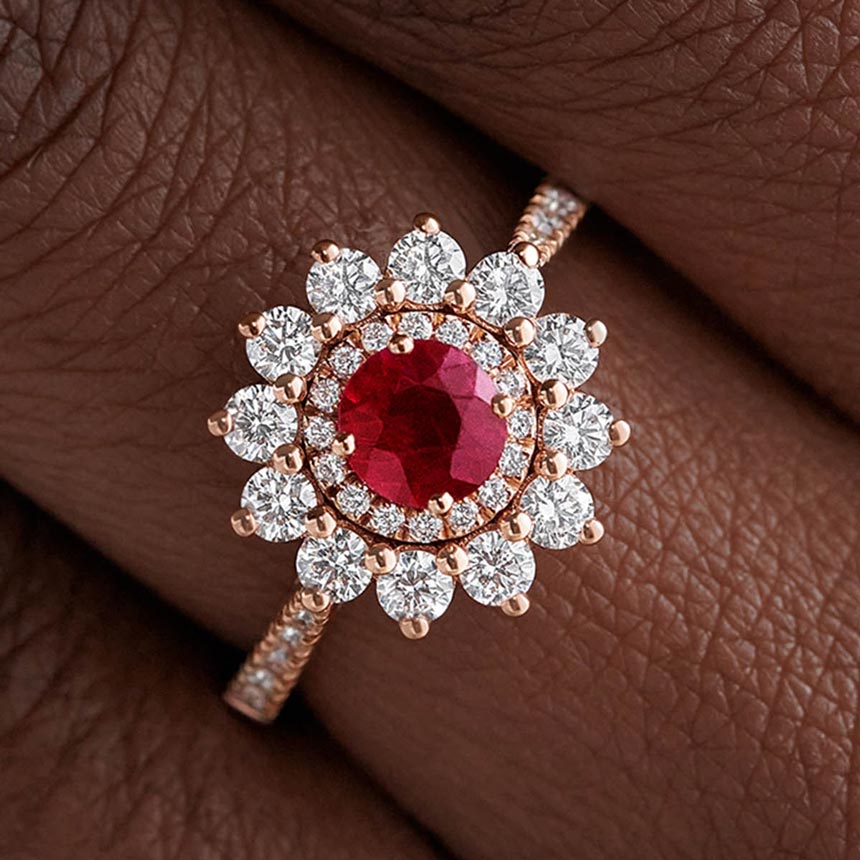
The quality of a ruby
—— 1. AAA quality, the highest quality for a coloured stone
Unlike diamonds, coloured stones do not have a standardised and internationally recognised system for comparing them.
That said, the certification of a coloured stone - such as a ruby - is just as rigorous as for a diamond and corresponds to three levels of quality:
-
A for medium and common quality.
-
AA for a rarer quality that is not especially used by big Maisons but rather by small local lapidaries. It refers to a superior quality with few defects and pronounced colours.
-
AAA the best quality for coloured stones. It means the the stone has a total absence of defects, is extremely shiny, and has pronounced and homogeneous colours.
How is this quality assessed for a ruby?
Well, it is directly inspired by the 4 universal Cs used for diamond certification! Namely:
-
The colour: whether it is natural or enhanced by treatment
-
The weight: the number of carats of the stone
-
The cut or faceting: the evaluation of the quality of the faceting of the stone and its shape
-
The purity: the presence or absence of inclusions visible to the naked eye or x10 magnifying glass
At Gemmyo, we certify that all our coloured stones - including ruby - are AAA quality. This certification from our gemologists guarantees that you are choosing a perfectly cut, shiny stone of the finest quality in circulation.
—— 2. Ruby is a naturally included stone
The natural ruby is a stone that has inclusions.
What does this mean?
An inclusion is an external element that has crept into the stone during its formation.
As with most natural stones, inclusions are perfectly normal. In fact, it is almost impossible to find a ruby without any inclusions.
Like a kind of fingerprint, this phenomenon makes a stone totally unique. It is even called the life of the stone. It is important to know that one of the characteristics of chromium oxide (which gives rubies their wonderful red colour) is the chemical property of creating inclusions. Therefore, the chromium creates the colour for the ruby, but also its impurities. It is therefore particularly rare to find perfectly crystalline rubies... some would even say that it is an anomaly of nature!
So what do the inclusions in a ruby look like?
They are often typical of its origin. For example, Burmese rubies have a kind of "frost" or "white veil" inside the stone that is not found in Mozambique rubies, which are clearer and purer.
These inclusions are stigmata of their geological formation in a particular area, like a signature, in this case of two different continents.
FAQs
—— "Where do your rubies come from?"
All Gemmyo rubies come from Sri Lanka and Thailand - two regions renowned for their rubies. They are recognisable by their raspberry-red colour.
—— "Are the rubies treated?"
The vast majority of the world's natural coloured stones are heated.
What does this mean?
Heating a stone is a process that has been used since the dawn of time on coloured stones in order to maintain its colour, strengthen it or simply to make it more resistant. It is a process that does not harm the stone, on the contrary, it even does it good! So don't be afraid of it!
Contrary to popular belief, unheated stones are extremely rare and, if it is not stated or if there is not a specific certificate attesting to this,it is unlikely that a stone is unheated. If you are told that it is an "unheated" ruby, beware unless you have a certificate from an independent laboratory. An unheated stone with a beautiful intensity of colour is so rare that its price is multiplied by 100 and is only used in very high jewelry for unique pieces.
Even if this process does not correspond to a specific treatment, it should obviously not be confused with chemical treatmentswhich are controlled by the State because they denature the stone, such as irradiation, filling of cracks, impregnation and colouring.
Gemmyo rubies are thus heated, which is a natural treatment, but we make sure to avoid all other treatments!
—— "Can rubies be certified by an international body?"
Yes, a ruby - like all coloured stones - can be certified by an international organisation such as the famous GIA - Gemological Institute of America.
At Gemmyo, we do not offer this certification. Why not?
Because the certification of a coloured stone by an international laboratory is very expensive - up to 500 dollars for a stone - and therefore has a significant impact on its purchase price. This type of certification is traditionally only done for absolutely exceptional stones whose origin must be certified... stones rarely worth less than CHF 10'000.–.
In order to guarantee you the fairest price and like most of the great jewelry houses, we have chosen to offer you coloured stones certified by our teams of gemologists, whose speciality and core business it is
—— "Which metal should be associated with ruby?"
The ruby can be perfectly associated with any type of metal!
Its bright colour allows for unique and original combinations. Rose gold will give an impression of perfect harmony with the stone; white gold or platinum will reveal its colour intensely. All choices are possible, it's only a matter of taste!
Our advice: Choose rose gold over yellow gold with a ruby if you want a less classic combination.
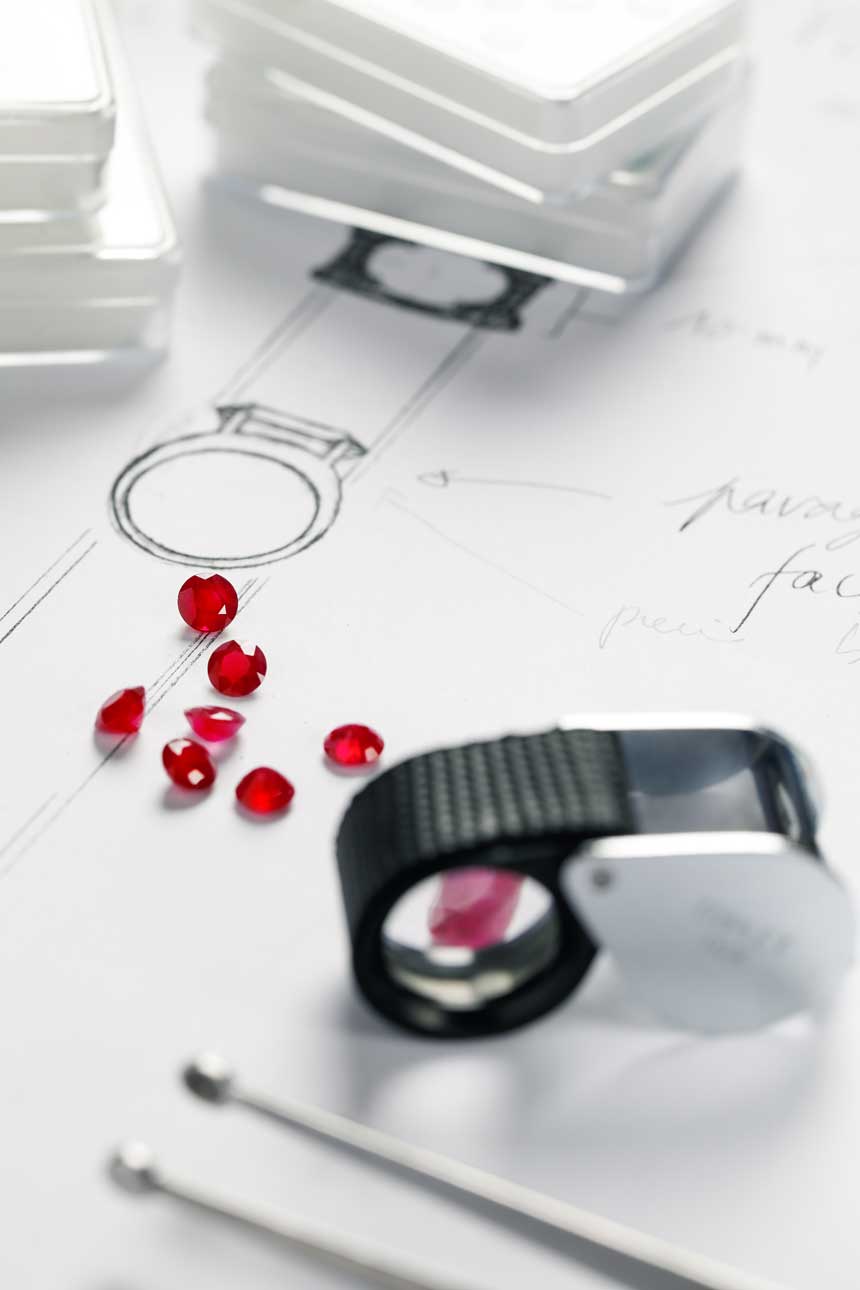
—— "What is the occasion for giving a ruby?"
A symbol of love, the ruby is often chosen for an engagement!
This stone is also traditionally given to celebrate the 15th - crystal wedding -and 35th wedding anniversary. Associated with the natives of the month of July but also with the zodiac sign of Leo, this is another good opportunity to mark a specific event or simply to please yourself!
Discover our ruby jewelry.
More specifically, discover our ruby engagement rings.
See all our precious stones.
















